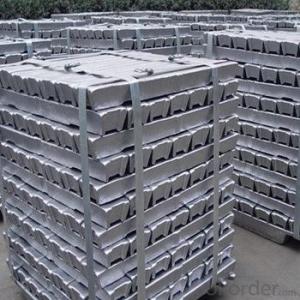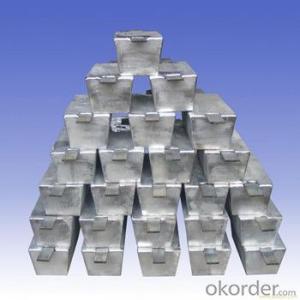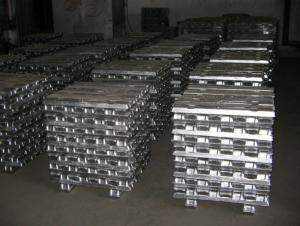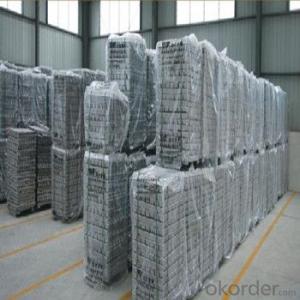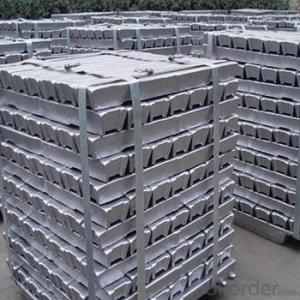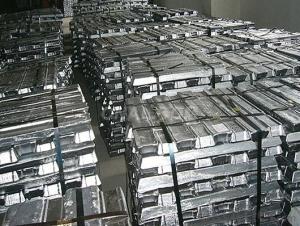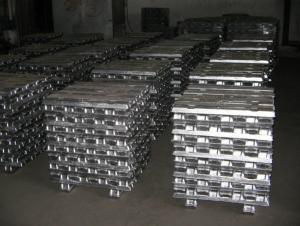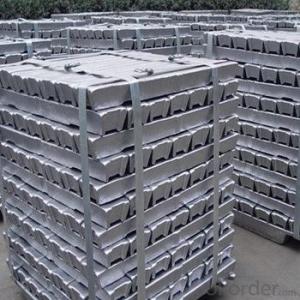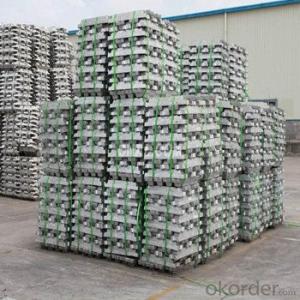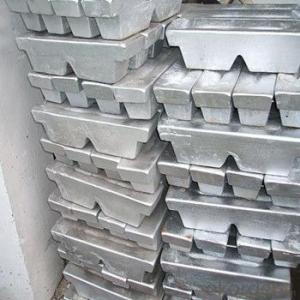Aluminium Ingot 99.97% for Choice with Top Quality
- Loading Port:
- China main port
- Payment Terms:
- TT OR LC
- Min Order Qty:
- 1000 m.t.
- Supply Capability:
- 10000 m.t./month
OKorder Service Pledge
OKorder Financial Service
You Might Also Like
Pure Aluminum Ingot Used for Industry
1.Structure of Aluminum Ingot Description
Aluminum Ingot is with the AL as the main chemical composition. Aluminum Ingot is used for industry,such as automobile,pinning and weaving,electron broadly and so on. Aluminum Ingot has the following advantages: easy control and operation, fast melting.
2.Main Features of the Aluminum Ingot
•High Purity
•Easy control and operation
•High strength
•Fast melting
•Competitive price
•Best Service
3. Aluminum Ingot Images

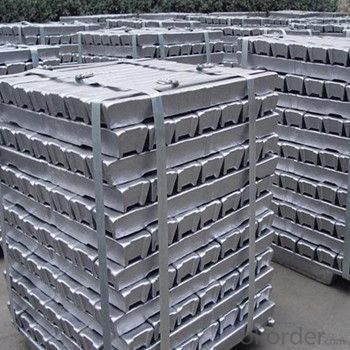
4. Aluminum Ingot Specification
Grade | Chemical Composition % | |||||||||
Al≥ | impurities ≤ | |||||||||
Si | Fe | Cu | Ga | Mg | Zn | Mn | others | Sum | ||
Al99.9 | 99.90 | 0.50 | 0.07 | 0.005 | 0.02 | 0.01 | 0.025 | - | 0.010 | 0.10 |
Al99.85 | 99.85 | 0.80 | 0.12 | 0.005 | 0.03 | 0.02 | 0.030 | - | 0.015 | 0.15 |
Al99.7 | 99.70 | 0.10 | 0.20 | 0.010 | 0.03 | 0.02 | 0.030 | - | 0.030 | 0.30 |
Al99.6 | 99.60 | 0.16 | 0.25 | 0.010 | 0.03 | 0.03 | 0.030 | - | 0.030 | 0.40 |
Al99.5 | 99.50 | 0.22 | 0.30 | 0.020 | 0.03 | 0.05 | 0.050 | - | 0.030 | 0.50 |
Al99.00 | 99.00 | 0.42 | 0.50 | 0.020 | 0.03 | 0.05 | 0.050 | - | 0.050 | 1.00 |
5.FAQ of Aluminum Ingot
We have organized several common questions for our clients,may help you sincerely:
①How about your company?
A world class manufacturer & supplier of castings forging in carbon steel and alloy steel,is one of the large-scale professional investment casting production bases in China,consisting of both casting foundry forging and machining factory. Annually more than 8000 tons Precision casting and forging parts are exported to markets in Europe,America and Japan. OEM casting and forging service available according to customer’s requirements.
②How to guarantee the quality of the products?
We have established the international advanced quality management system,every link from raw material to final product we have strict quality test;We resolutely put an end to unqualified products flowing into the market. At the same time, we will provide necessary follow-up service assurance.
③How long can we receive the product after purchase?
In the purchase of product within three working days, We will arrange the factory delivery as soon as possible. The pecific time of receiving is related to the state and position of customers.Commonly 7 to 10 working days can be served.
- Q:How are aluminum ingots alloyed with other metals?
- Aluminum ingots are alloyed with other metals by melting them together and adding the desired alloying elements in specific proportions to achieve the desired properties. This can be done through various methods such as direct alloying, which involves adding the alloying elements directly to the molten aluminum, or through pre-alloying, where the alloying elements are pre-mixed and melted with the aluminum. The alloying process is crucial in enhancing the strength, corrosion resistance, and other desired characteristics of aluminum for various applications.
- Q:Can aluminum ingots corrode?
- Indeed, it is possible for aluminum ingots to experience corrosion. Despite being renowned for its resistance to corrosion, aluminum is not entirely impervious to it. When subjected to specific environments, like those containing high salt or acid concentrations, aluminum can undergo a process known as oxidation. This process gives rise to the formation of a thin layer of aluminum oxide on the surface of the metal, which serves as a safeguard, preventing further corrosion. Nonetheless, if this protective layer becomes damaged or compromised, the underlying aluminum can become vulnerable to corrosive elements, ultimately resulting in corrosion. Consequently, although aluminum ingots generally display resistance to corrosion, it is crucial to exercise proper caution and take necessary measures to shield them in corrosive surroundings.
- Q:Can aluminum ingots be customized for specific applications?
- Certainly, specific applications can have customized aluminum ingots. Aluminum, a remarkably adaptable metal, can be effortlessly shaped to fulfill diverse needs. Typically, the customization procedure includes combining the aluminum with other elements to amplify qualities like strength, hardness, resistance to corrosion, and thermal conductivity. Furthermore, the ingots can undergo various heat treatment methods such as annealing, quenching, and tempering to further adjust their properties. Consequently, aluminum ingots that are precisely designed for particular applications can be manufactured, encompassing a wide range from automotive parts and aerospace components to construction materials and consumer products.
- Q:What are the challenges in recycling scrap aluminum ingots?
- There are several challenges in recycling scrap aluminum ingots. Firstly, one of the major challenges is the collection and sorting of the scrap aluminum. As aluminum is used in a wide range of products, it can be found in various forms and shapes, making it difficult to collect and sort efficiently. This requires an extensive and organized collection network to ensure the scrap aluminum is properly segregated. Another challenge is the presence of impurities in the scrap aluminum. Impurities such as paint, coatings, and other contaminants need to be removed before the aluminum can be recycled. This requires additional processes and treatments to ensure the quality of the recycled aluminum meets the required standards. Furthermore, the energy-intensive nature of aluminum recycling poses a challenge. Recycling aluminum requires melting the scrap ingots at high temperatures, which requires a significant amount of energy. This can be a challenge in terms of cost and environmental impact, as the energy consumption and emissions associated with the recycling process need to be carefully managed. Additionally, the market demand and fluctuating prices of aluminum can pose challenges in recycling scrap aluminum ingots. The availability of cheaper primary aluminum can sometimes make it more economically viable to produce new aluminum rather than recycling the scrap ingots. This can impact the overall recycling rates and the viability of recycling operations. Lastly, the transportation and logistics involved in recycling scrap aluminum ingots can also be a challenge. As scrap aluminum is often collected from various sources, transporting it to recycling facilities can be logistically complex and costly. Efficient transportation networks need to be established to ensure the smooth flow of scrap aluminum to recycling facilities. Overall, while recycling scrap aluminum ingots offers numerous benefits, there are several challenges that need to be addressed to ensure a successful and sustainable recycling process.
- Q:Process description of aluminium ingot
- Casting alloy ingots must be clarified for more than 30min. After cleaning, the slag can be cast. When casting, the furnace of the mixing furnace is aligned with the second and third moulds of the casting machine, so as to ensure the change of the liquid flow and a certain flexibility when changing the die. Furnace eyes and casting machine with a groove connection groove shorter is better, it can reduce the oxidation of aluminum, avoid vortex and splash, casting machine above disable 48h, restart, will die at 4h. The liquid aluminum mold with a shovel into the groove, the surface of liquid aluminum oxide film is removed, called slag. Flow with the first mock exam, will move down a chute mould casting machine is a continuous progress. The mould is moved in sequence, and the aluminum liquid is cooled gradually. When the casting machine reaches the middle of the casting machine, the aluminum liquid has been solidified into aluminium ingot, and the smelting number is printed by the printer. When the aluminum ingot reaches the top of the casting set, it has been completely solidified into aluminum ingot. At this time, the mold is turned over and the ingot is released and dropped on the automatic ingot car. The stacker is automatically stacked and bundled to become the finished aluminum ingot. The casting machine is cooled by spraying water, but must be started in the casting machine, turn full circle before water can be supplied. The aluminum liquid consumes about 8-10t water per ton, and a blower is needed to cool the surface in summer. The casting ingot belongs to the flat mold casting, the solidification direction of the aluminum liquid is from bottom to top, and the upper part is solidified at last, leaving a groove depression. The solidification time and the condition of each part of the aluminium ingot are different, so their chemical composition will be different, but it is in conformity with the standard as a whole.
- Q:What are the advantages of using aluminum ingots in the production of consumer electronics?
- There are several advantages of using aluminum ingots in the production of consumer electronics: 1. Lightweight: Aluminum is a lightweight material, making it ideal for consumer electronics where portability is a key consideration. It allows for easier handling and transportation of devices, making them more convenient for consumers to use and carry. 2. Durability: Aluminum is known for its excellent strength-to-weight ratio, which means it can withstand high levels of stress without compromising its structural integrity. This durability ensures that consumer electronics made from aluminum ingots are less prone to breakage or damage, increasing their longevity and reliability. 3. Heat dissipation: Consumer electronics often generate heat during operation, and aluminum's high thermal conductivity helps in dissipating this heat efficiently. This property allows for better heat management, preventing overheating and ensuring the optimal performance of the devices. 4. Corrosion resistance: Aluminum has a natural oxide layer that forms on its surface, providing excellent resistance against corrosion. This makes it suitable for consumer electronics that may be exposed to moisture or humidity, such as smartphones or laptops, as it helps protect the internal components from damage. 5. Aesthetics: Aluminum has a sleek and modern appearance, giving consumer electronics a premium and sophisticated look. Its ability to be easily molded into various shapes and sizes allows for sleek designs that attract consumers who value aesthetics. 6. Eco-friendly: Aluminum is highly recyclable, and using aluminum ingots in the production of consumer electronics promotes sustainability. It reduces the need for extracting and processing raw materials, conserves energy, and minimizes environmental impact compared to other materials like plastic or steel. Overall, the advantages of using aluminum ingots in the production of consumer electronics include lightweight portability, durability, effective heat dissipation, corrosion resistance, attractive aesthetics, and environmental sustainability.
- Q:How are aluminum ingots extracted from bauxite ore?
- The process known as the Bayer process is utilized to extract aluminum ingots from bauxite ore. This process consists of several sequential stages: 1. Mining: Bauxite ore is typically sourced from near the Earth's surface and extracted through open-pit mining techniques. Subsequently, the ore is transported to a processing facility for further preparation. 2. Crushing and Grinding: The bauxite ore is subjected to crushing and grinding, resulting in the formation of fine particles. This step enhances the ore's surface area, facilitating the extraction of aluminum during the digestion process. 3. Digestion: The crushed and ground bauxite ore is combined with a hot caustic soda solution within large pressure vessels called digesters. This mixture is heated and agitated, causing a chemical reaction wherein aluminum oxide (alumina) present in the bauxite ore dissolves into the caustic soda solution. Additionally, other impurities in the ore, such as iron oxides, silica, and titanium oxide, also dissolve or transform into soluble compounds. 4. Clarification: The resulting combination, referred to as a slurry, is subsequently passed through a series of settlement tanks to separate the solid impurities from the liquid. The settled solids, known as red mud, are eliminated, while the clarified liquid containing dissolved alumina is collected. 5. Precipitation: The dissolved alumina in the liquid is cooled and treated with additional chemicals to induce crystallization. This step allows the alumina to precipitate as fine particles. 6. Calcination: The precipitated alumina is then subjected to elevated temperatures in a kiln, a process termed calcination. This stage eliminates any remaining water and converts the alumina into a more stable form known as alumina trihydrate. 7. Smelting: The alumina trihydrate is subsequently heated in specialized furnaces, where it undergoes a process known as smelting. The heat leads to the decomposition of alumina, liberating oxygen and leaving behind pure aluminum oxide. 8. Electrolysis: The aluminum oxide is dissolved in a molten cryolite bath, and an electric current is passed through the bath. This process, termed electrolysis, prompts the migration of aluminum ions to the cathode, where they are reduced and deposited as molten aluminum. The molten aluminum is then cast into ingots or other desired forms. In summary, the extraction of aluminum ingots from bauxite ore entails a succession of chemical and physical operations that aim to separate the aluminum from other impurities and convert it into a form suitable for utilization.
- Q:What is the role of aluminum ingots in the production of aircraft?
- Aluminum ingots play a crucial role in the production of aircraft as they are the primary raw material used in manufacturing various components, such as the fuselage, wings, and other structural parts. Due to its lightweight, high strength, and corrosion-resistant properties, aluminum is an ideal material for aircraft construction. The ingots are melted down and transformed into sheets, plates, and extrusions, which are then fabricated and assembled into the airframe. This versatile metal allows for weight reduction, increased fuel efficiency, and improved performance, making it an essential element in modern aircraft production.
- Q:What are the energy requirements for producing aluminum ingots?
- The energy requirements for producing aluminum ingots are significant, as the production process involves several stages that consume large amounts of electricity. The primary energy-intensive steps include mining and refining bauxite ore into alumina, which requires a substantial amount of electrical power. Additionally, the electrolytic reduction of alumina to aluminum in the smelting process demands a significant energy input. Overall, the production of aluminum ingots is an energy-intensive process that necessitates substantial electricity consumption.
- Q:What are the benefits of using aluminum ingots in the construction of lightweight structures?
- There are several benefits of using aluminum ingots in the construction of lightweight structures. Firstly, aluminum is a lightweight metal, making it an ideal choice for constructing lightweight structures. It has a density that is approximately one-third of steel, allowing for the creation of structures that are significantly lighter in weight. This is particularly advantageous in industries such as aerospace, automotive, and marine, where reducing weight is crucial for improving fuel efficiency and overall performance. Secondly, aluminum is highly corrosion-resistant. Unlike other metals, such as steel, aluminum does not rust when exposed to moisture or other corrosive elements. This makes it an excellent choice for structures that are exposed to harsh environmental conditions, such as buildings near the coast or in areas with high humidity. By using aluminum ingots, the structures can withstand corrosion, ensuring their longevity and reducing maintenance costs. Furthermore, aluminum is a highly malleable material, allowing for greater design flexibility. It can be easily shaped and formed into various complex geometries, enabling architects and engineers to create innovative and aesthetically pleasing structures. This versatility in design also allows for efficient use of materials, reducing waste and maximizing the structural integrity of the lightweight construction. Another significant benefit of using aluminum ingots is their excellent strength-to-weight ratio. Despite being lightweight, aluminum structures can still possess impressive strength and durability. This makes them suitable for applications where both strength and weight reduction are essential, such as in the construction of aircraft, high-rise buildings, and bridges. Additionally, aluminum is a sustainable material as it is highly recyclable. It can be melted down and reprocessed repeatedly without losing its properties, making it an environmentally friendly choice. By using aluminum ingots, construction projects can contribute to the circular economy and reduce the demand for new raw materials. In conclusion, the use of aluminum ingots in the construction of lightweight structures offers numerous benefits. These include reduced weight, corrosion resistance, design flexibility, excellent strength-to-weight ratio, and sustainability. Incorporating aluminum into construction projects can lead to improved performance, increased efficiency, and reduced environmental impact.
1. Manufacturer Overview |
|
|---|---|
| Location | |
| Year Established | |
| Annual Output Value | |
| Main Markets | |
| Company Certifications | |
2. Manufacturer Certificates |
|
|---|---|
| a) Certification Name | |
| Range | |
| Reference | |
| Validity Period | |
3. Manufacturer Capability |
|
|---|---|
| a)Trade Capacity | |
| Nearest Port | |
| Export Percentage | |
| No.of Employees in Trade Department | |
| Language Spoken: | |
| b)Factory Information | |
| Factory Size: | |
| No. of Production Lines | |
| Contract Manufacturing | |
| Product Price Range | |
Send your message to us
Aluminium Ingot 99.97% for Choice with Top Quality
- Loading Port:
- China main port
- Payment Terms:
- TT OR LC
- Min Order Qty:
- 1000 m.t.
- Supply Capability:
- 10000 m.t./month
OKorder Service Pledge
OKorder Financial Service
Similar products
New products
Hot products
Hot Searches
